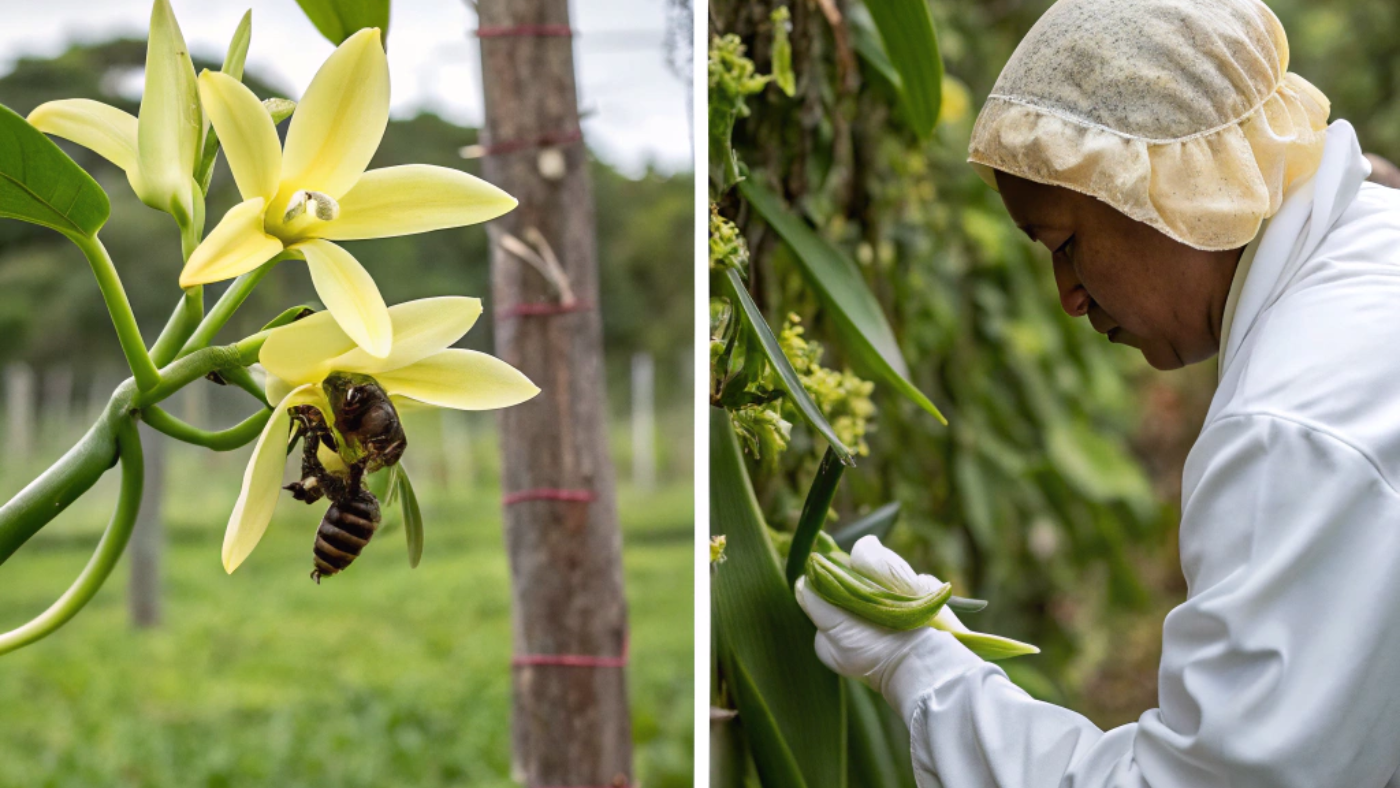Vanilla is one of the most prized and valuable spices in the world, yet its cultivation presents unique challenges, especially when it comes to pollination. This guide explores the fascinating world of vanilla plant pollination, explaining why hand pollination is essential and how growers from home gardeners to commercial farmers can master this delicate process.
Whether you’re a culinary artisan, a small-scale farmer, or someone passionate about sustainable agriculture, this vanilla cultivation guide will provide you with the knowledge and confidence to successfully hand-pollinate your vanilla orchids.
Why Vanilla Plant Pollination Requires Hand-Pollination

The Natural Pollination Challenge of Vanilla Orchids
Vanilla orchids rely on very specific pollinators in their native habitat, primarily the Melipona bees. These tiny stingless bees have evolved a specialized relationship with vanilla flowers, enabling natural pollination. However, outside vanilla’s native regions in Mexico and Central America, these vanilla natural pollinators are absent or ineffective, creating a significant hurdle for vanilla fruit production.
Without the Melipona bees or similar pollinators, vanilla flowers often fail to set fruit, drastically reducing vanilla bean yield. This natural limitation is a key reason why vanilla cultivation depends heavily on human intervention.
The Crucial Role of Hand Pollination in Vanilla Cultivation
The history of vanilla pollination is intertwined with the story of Edmond Albius, a young enslaved boy from Réunion Island who, in 1841, discovered the technique of manual pollination vanilla orchid. This breakthrough overcame the natural pollination barrier and revolutionized vanilla farming worldwide.
Today, hand pollination remains indispensable for vanilla production. It allows growers to control fertilization precisely, ensuring consistent and abundant vanilla bean harvests. Understanding this history underscores the importance of manual pollination in the global vanilla industry.
How Do You Pollinate Vanilla? A Step-by-Step Guide

Understanding Vanilla Flower Anatomy for Successful Pollination
Successful vanilla plant pollination starts with understanding the flower’s unique anatomy. Key parts include the labellum (the flower’s lip), rostellum (a flap that separates male and female parts), anther (male pollen-producing part), and stigma (female receptive part).
This complex structure makes natural pollination difficult, as the rostellum physically blocks pollen from reaching the stigma without the help of specific pollinators or human hands.
Essential Tools and Optimal Timing for Hand Pollination
To hand-pollinate vanilla flowers effectively, growers use simple tools like toothpicks, bamboo sticks, or specialized pollination instruments. Timing is critical: the best time to pollinate vanilla is early morning, within hours of flower opening, when the flower is mature but before it wilts.
Detailed Step-by-Step Vanilla Hand Pollination Process
-
Identify flowers ready for pollination typically freshly opened flowers receptive for about 12 hours.
-
Lift the rostellum gently to expose the anther and stigma.
-
Transfer pollen from the anther to the stigma carefully using your tool.
-
Avoid common mistakes such as damaging the flower or missing the stigma.
-
Monitor for fertilization signs, such as flower wilting and early pod development.
Mastering these vanilla pollination steps ensures higher fruit set and better crop yields.
Common Challenges in Vanilla Plant Pollination and Cultivation

Labor Intensity and Economic Impact of Hand Pollination
Hand pollination is labor-intensive and time-consuming, making it a significant bottleneck in vanilla production. This labor demand directly influences vanilla prices and supply chain dynamics, contributing to vanilla’s high market value.
Environmental and Climatic Factors Affecting Vanilla Pollination
Vanilla flowering and pollination success depend heavily on climate. Ideal conditions include warm temperatures and high humidity, but weather variability can disrupt bloom cycles and reduce fruit set, presenting ongoing challenges for growers.
Pest and Disease Risks During the Pollination Window
Vanilla flowers and young pods are vulnerable to pests like thrips and diseases such as fungal infections. Protecting plants during the pollination period with proper sanitation and organic controls is vital for healthy vanilla cultivation.
Vanilla Flower Anatomy and Blooming Behavior in Pollination
Lifecycle and Bloom Duration of Vanilla Flowers
Vanilla flowers have a very short lifespan, typically blooming for only one day. This brief vanilla flower receptivity window demands precise timing for pollination to succeed.
Flower Morphology’s Impact on Pollination Success
Understanding vanilla flower morphology the detailed structure of the orchid helps growers perfect their pollination technique. Knowledge of floral parts and their functions improves manual pollination efficiency and crop outcomes.
Comparing Natural and Manual Vanilla Plant Pollination

Pollination Efficiency and Crop Yield Outcomes
Natural pollination by wild pollinators is rare outside vanilla’s native habitat, resulting in low fruit set. In contrast, manual pollination dramatically increases vanilla pollination efficiency, leading to higher yields and superior bean quality.
Practicality of Pollination Methods for Commercial Vanilla Growers
Given the scarcity of natural pollinators, commercial vanilla farms rely almost exclusively on hand pollination. This method remains the industry standard due to its reliability and scalability.
Environmental and Ethical Considerations in Vanilla Pollination
Manual pollination supports sustainable vanilla farming by ensuring crop success without relying on introduced pollinator species. Ethical labor practices and fair trade are essential components of responsible vanilla production
Conclusion
Mastering vanilla plant pollination is critical for anyone serious about vanilla cultivation. Whether you’re a home gardener or a commercial farmer, adopting proven hand pollination techniques can dramatically improve your vanilla bean yield and quality.











